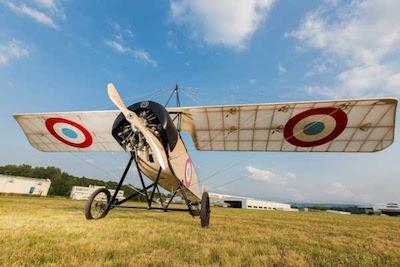Flightworthy Replica Of The Morane-Saulnier Type L “Parasol” Aeroplane On Display
A flightworthy replica of the World War Iera Morane-Saulnier Type L “Parasol” aeroplane – an ancestor to Daher’s TBM very fast turboprop aircraft – is being showcased this week at AirVenture.

This historic airplane is the result of a six-year adventure that started in 2011 with the 100th anniversary of Daher’s roots as an aircraft manufacturer. The Type L replica project has been supported from the start by Daher, which provides workspace, tooling and expertise.
“We decided to exhibit the Type L at Oshkosh in 2017 because this year marks the 100th anniversary of the United States’ entry into World War I – which had an enormous influence in the development of aviation,” explained Nicolas Chabbert, the Senior Vice President of Daher’s Airplane Business Unit, and President of SOCATA North America, its U.S subsidiary.
The replica’s construction project is managed by the Association Héritage Avions Morane-Saulnier, whose volunteers – both retired and current workers of Daher and its predecessor companies – have brought their energy and passion to this effort. Some of them are Morane-Saulnier veterans in their mid-80s. This replica retains the Type L’s Parasol’s original wooden structure, along with the wing-warping system and the aircraft’s all-flying rudder and stabilator controls.
To date, over 15,000 man-hours have been invested by the group of volunteers in various tasks ranging from woodworking to computer-assisted design. As the MoraneSaulnier aircraft is being built to fly, modern upgrades have been incorporated, including the substitution of a 110 hp. Rotec radial engine in place of the original Le Rhone rotary 80-hp engine.
“Giving a ‘rebirth’ to the Type L represents the excellence in manufacturing and ingenuity that is reflected today in our TBM 910 and TBM 930 aircraft – which are recognized for their performance and quality,” Chabbert added.
As the replica is fragile, and represents an oversized load for standard containers (with a 23 ft.-long fuselage), the Daher parent company’s special projects department designed and built a tailor-made container for the shipment – ensuring this symbol of aviation history is protected, while making the trans-Atlantic shipment practical. For its trip from Europe to America, the container initially traveled by truck to France’s Le Havre harbor for the ocean crossing by ship to New York Harbor, then continued by road to Wisconsin. Its movements are monitored by Daher’s transportation department, providing an in-service validation of Daher’s Connected Container system. This container is equipped with a tracking box to ensure the unique cargo is followed throughout its travels – even in depths of the ship’s hull.
“We thank Daher for the fantastic support it brought to our project. Every level of the company – from top executives to workers on the production floor and in the shops – made a contribution to this project from the start, when it was difficult to imagine we could bring this element of aviation history to life,” said Daniel Bacou, President of the Association Héritage Avions Morane-Saulnier. “Having the ‘Parasol’ replica at Oshkosh is simply a dream come true for our members.”
When U.S. entered in World War I, the U.S. Army Air Service needed to train thousands of pilots, and the service created flight schools in France – including the large Issoudun operation, established in July 1917.
Morane-Saulnier’s contribution to this massive effort was to provide the Parasol aeroplanes as training aircraft. Some of them were converted as “Morane rouleurs” for preliminary training. The “rouleur” function was to teach fledging pilots to properly taxi the aircraft before starting to fly in dual-control airplanes. The brand became popular, and other Morane-Saulnier aircraft, such as Type AI fighters, were purchased by the U.S. Army and brought back to the American continent – where they served until the 1920s.
(Source: Daher news release)
 Airborne-Flight Training 05.09.24: ERAU at AIAA, LIFT Diamond Buy, Epic A&P
Airborne-Flight Training 05.09.24: ERAU at AIAA, LIFT Diamond Buy, Epic A&P ANN's Daily Aero-Term (05.07.24): Hazardous Weather Information
ANN's Daily Aero-Term (05.07.24): Hazardous Weather Information Aero-News: Quote of the Day (05.07.24)
Aero-News: Quote of the Day (05.07.24) NTSB Final Report: Cessna 150
NTSB Final Report: Cessna 150 Aero-News: Quote of the Day (05.08.24)
Aero-News: Quote of the Day (05.08.24)



